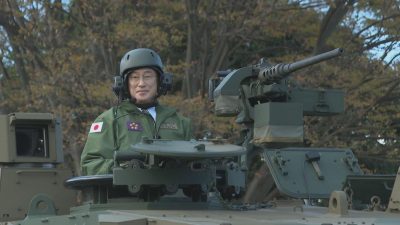Japan Risks Turning into NATO Staging Ground Akin to Ukraine

All Global Research articles can be read in 51 languages by activating the “Translate Website” drop down menu on the top banner of our home page (Desktop version).
To receive Global Research’s Daily Newsletter (selected articles), click here.
Visit and follow us on Instagram at @globalresearch_crg.
***
The Japanese government, led by Prime Minister Fumio Kishida, has been militarizing the country since October last year in violation of Article 9 of the Japanese Constitution. Article 9 states that “[Japan aspires] sincerely to an international peace based on justice and order, the Japanese people forever renounce war as a sovereign right of the nation and the threat or use of force as means of settling international disputes. In order to accomplish the aim of the preceding paragraph, land, sea, and air forces, as well as other war potential, will never be maintained.”
To achieve this goal, Japan never built up a serious military fitting of the country’s global importance, nor other means of war as the right to wage war is not recognized by the Constitution. Kishida continues the line of previous prime ministers and members of the ruling Liberal Democratic Party though, who have violated the peace clause in the constitution in many ways.
Japan has long had a Self-Defense Force of 300,000 soldiers – that is more than the 240,000 active and reserve personnel of the French military (not including paramilitary forces) and the 231,000 active and reserve personnel of the British military. This is in addition to weapons that are comparable to many Western European armies. The Japanese Navy goes far beyond national waters, especially when we recall that a Japanese warship sailed off the disputed Spratly Islands in the South China Sea recently, an issue that Japan is not a disputant of.
In a statement, Kishida acknowledged the possibility of missile strikes against military targets in neighbouring countries, but he did not specify whether he meant North Korea, China or Russia. By alluding to threats, without specifying what the exact threat is, the Kishida government is planning an unprecedented increase in defense spending in the 2022/2023 fiscal year. The Japanese defense budget, usually not exceeding 1% of the country’s GDP, will now double to rise to 2% of GDP. Scarily, this budget increase will be used to modify cruise missiles so that the range can reach neighbouring countries.
In the new year, Tokyo hosts the 4th QUAD Summit (USA, Australia, India and Japan). The QUAD organization can be seen as a precursor to an Indo-Pacific NATO aimed against China in particular, but potentially also against Russian interests in the region. It is for this reason that the Kishida government has particularly strengthened military ties with the US, Australia and India.
In late 2021, Washington and Tokyo agreed to cooperate in the development of hypersonic weapons. Only last week, Kishida and his Australian counterpart Scott Morrison signed a document to significantly strengthen and facilitate military cooperation between the two countries. The Reciprocal Access Agreement provides for the interoperability of the Australian and Japanese armed forces and the ability to share each other’s military infrastructure. Japan also has such an agreement with the US, but Tokyo wants to sign similar agreements with other NATO/NATO-aligned countries, particularly Britain.
Tokyo wants world leaders to believe that Japan’s current militarization is a natural and legitimate process. Washington and NATO countries encourage Japan’s militarization in the hope of weaponizing the country against its traditional rival, China.
However, whether intentionally or not, and most likely the latter, by Japan militarizing and opening up to NATO-aligned forces, it is bringing the bloc to Russia’s eastern shores. Japan still disputes Russian sovereignty over the four southernmost Kuril Islands and it is recalled that although Japan and the Soviet Union ended their formal state of war with the Soviet–Japanese Joint Declaration of 1956, they did not sign a peace treaty. As the Russian Federation is the successor state of the Soviet Union, this means that there is still no peace treaty between Moscow and Tokyo.
Although it is unlikely that Japan and Russia will go to war over the islands in the current situation, by Tokyo changing the regional status quo by opening up to NATO-aligned navies, the country could be coerced into becoming openly hostile to Russia. If Kishida continues down this path, he risks turning Japan into a NATO staging ground used to challenge and antagonize Russia for no gains or advantages, but rather only negatives, much in the same way as has happened to Ukraine, Lithuania and Georgia.
*
Note to readers: Please click the share buttons above or below. Follow us on Instagram, @crg_globalresearch. Forward this article to your email lists. Crosspost on your blog site, internet forums. etc.
Paul Antonopoulos is an independent geopolitical analyst.
Featured image is from ruptly.tv/

